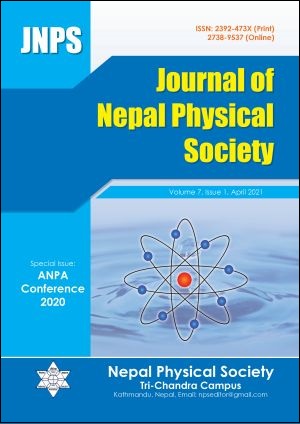The dependence of the Irregularity Parameter Characterizing the Equatorial Ionospheric Irregularities on the background Ionospheric Density
DOI:
https://doi.org/10.3126/jnphyssoc.v7i1.36967Keywords:
Equatorial ionospheric irregularities, Physics-based model (PBMOD), Ionospheric densityAbstract
The low-latitude ionosphere is characterized by large-scale instabilities in the post-sunset hours due to the distinct geometry of the earth’s magnetic field lines at the equator. The magnetic field lines are horizontal at the equator contributing to the high vertical drift velocity of the plasma bubbles growing from the bottomside of the ionospheric F-region. The phenomenon, commonly known as equatorial spread F, is an important problem in aeronomy as it can cause radio wave scintillation effects representing the most critical impacts of space weather on man-made technologies, such as satellite communications and global navigation satellite systems (GNSS). Here, we report results on the dependence of the peak heights of the irregularities at the magnetic equator, also called as apex-altitude, on solar flux by analyzing in-situ observations made on-board the Communications/Navigations Outage Forecasting System (C/NOFS) satellite mission. Our analysis indicates the median of the peak-height distributions of the irregularities increases linearly from about 491 km at solar minimum to 737 km during solar maximum. The Physics-Based Model (PBMOD) has been used to confirm the space-based observational results and we find the field-line integrated conductivity is the key parameter which controls the peak-heights of the irregularities. In this investigation, we also seek to understand the possible dependence of the irregularity parameter characterizing the equatorial ionospheric irregularities on the background ionospheric density.
Downloads
Downloads
Published
How to Cite
Issue
Section
License
All right reserved. No part of this Journal may be reproduced in any form or by any electronic or mechanical means, including information storage and retrieval system, without permission in writing from the publisher, except by a reviewer who may quote brief passage in a review. The views and interpretation in this journal are those of author(s) and they are not attributable to the NPS.




